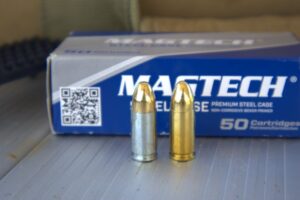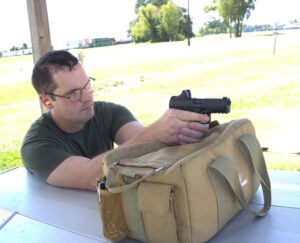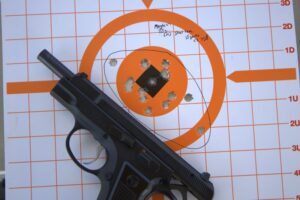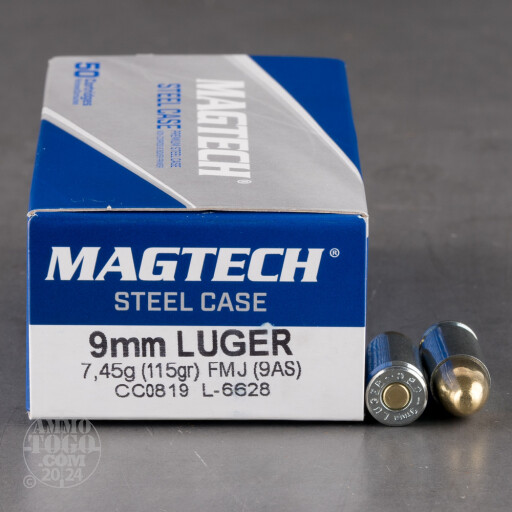We take Magtech Steel Cased 9mm ammo out for a range review. Could this be the steel case we’ve been waiting for?
Steel cased ammunition puts holes in things at a price point lower than conventional brass case practice loads. These rounds, regardless of caliber, offer an affordable way to start shooting and keep going without breaking the bank. Many people complain about steel-cased ammunition. There’s good reason for it. More recently, the overall complaint is that you simply cannot find steel cased rounds as in the past. Russia was a primary supplier of steel case ammunition up until sanctions levied in 2023.
Thankfully, the new Magtech Steel Case 9mm round represents the start of a new way forward for thrifty shooters. Delivering superior performance compared to those verboten Russian-made rounds.
Magtech’s Steel Case 9mm: The Differences
Eastern European made steel cased ammunition had one major thing going for it—price. These rounds used cheaper steel cases and bimetal jackets consisting of a lead bullet with a steel jacket fronted by a thin copper coat. Manufacturers apply a lacquer finish to these ComBloc rounds because bare steel lacks the lubricity of brass. Although these rounds are cheap to shoot, shooters have long reported this ammunition as “dirty.” The reason being, lacquer coating tends to melt in the chamber, inducing malfunctions over time. Other complaints include increased barrel wear due to the bullet’s construction. Bi-metal composition, hard primers, and the mild steel cases damage bolts, extractors, and chambers.
Although some of these issues are exaggerations, some of them are real and it leaves some shooters with a bad taste for steel cased ammunition. MagTech introduced their first steel cased ammunition in 2024 with a 9mm Luger 115 grain FMJ offering. This bulk range ammunition solves potential issues with steel-cased rounds while staying affordable.
Magtech’s Steel Case 9mm ammunition uses boxer primers like conventional American and European ammo. Russian steel-cased rounds typically use berdan primers. Boxer primers have more combustible components and an internal anvil that make them more reliable when struck by the firing pin.
The case itself is still mild steel, but in lieu of a lacquer coating, Magtech used zinc coating. The 115 grain FMJ bullet is a conventional lead core round with a copper jacket. The bimetal construction used in other steel cased ammunition is taken off the table.
On the Range with the Magtech Steel Case 9mm Ammunition
To see if MagTech’s 9mm Steel Case ammunition performs as well as it looks compared to the old alternatives, I wrangled up a few fifty round boxes, my Caldwell chronograph, some targets, and a few firearms chambered in 9mm. These firearms include the new Arex Delta Gen. 2 and my venerable CZ-75B to fill the slots for a compact and full-sized handgun. As 9mm carbines have gotten more popular, I packed along a Palmetto State Armory AR9 carbine for good measure.
Velocity and Accuracy
A common criticism of steel cased ammunition is the inconsistent loading of the powder, resulting in vast differences in velocity from shot to shot. If rounds do not come out of the barrel at roughly the same speed, how are we to expect to hit in the same place?
I started my test of the Magtech Steel Case 9mm by setting out my chronograph ten feet from the firing line. I shot a series of five-shot groups from my handguns and then the carbine. The Arex Delta has a 4 inch barrel and the CZ, a 4.6 inch barrel. The AR9 has a full 16-inch barrel. I also had targets posted at ten yards to catch the impacts and provide a point of reference to aim.
| Firearm | Muzzle Velocity (fps) | Accuracy (Inches) |
|---|---|---|
| Arex Delta Gen. 2 M | 1121 | 2.8 inches |
| CZ-75B | 1148 | 1.5 inches |
| PSA AR9 | 1232 | 1 inch |
The handguns came close to the advertised muzzle velocity of 1,135 feet per second and the difference in accuracy from the bench only came down to the difference in triggers between each handgun. I can simply shoot the CZ better. The PSA, with its longer barrel, gave us a 111 feet per second premium over a compact 9mm handgun in our Arex Delta.
The more important result, though, was the differences from shot to shot. The extreme spread of this batch at this time with this chronograph was no more than 20 feet per second from the lowest velocity to the highest in any five-round string. That is premium hollow-point territory in terms of consistency!
Accuracy on the bench was mirrored with some offhand shooting. The rifle, mounted with a red dot, gave me an advantage over the handguns, but I was still better with the CZ compared to the Arex, even though the Arex is wearing a 3 MOA dot. In any event, I found the accuracy regardless of platform to be a cut above the old ComBloc fodder.
Reliability
Any talk of steel cased ammo can’t be complete without talking about reliability, which come down to failures to cycle and failures to fire.
In some guns, traditional steel cased loads work very well but in others, not so much. Failures to go into battery are common as the lacquer coatings from the ammunition melt as the gun heats up. Steel also does not expand in the chamber like brass does, which causes more fouling to accumulate there. Regular steel cased ammo is also loaded with harder Berdan primers that can be harder for the firing pin to set off.
While I would not refer to Magtech’s new 9mm Steel Case ammunition as an equivalent to brass cased loads in terms of performance, the round’s design mitigates much of the criticism assigned to steel cased ammo. Out of the two-hundred-fifty rounds I tested, I counted only three failures to go into battery when firing the Arex Delta. A quick smack on the back of the slide brought the pistol back into action. After the first magazine, the Arex shot the remaining ammunition well. I had similar issues with the Arex when I first broke it in using brass-cased FMJ. I experienced no failures to cycle with either the CZ-75 or the AR9. Furthermore, I never had a failure to fire in any of the test guns.
Magtech 9mm Steel Case: Buy Cheap and Stack Deep
Magtech’s 9mm Steel Case ammunition is intended to be a reliable, inexpensive range and training option. At this, it exceeds expectations. The only aspect I was unable to test is the long-term wear on firearms through prolonged use of steel cased ammo instead of softer brass. I haven’t fired the thousands of rounds it would take to produce that kind of wear, if it materially exists. But if it does, I believe Magtech’s use of zinc plating is a more effective barrier between case and parts than lacquer as evidenced by less fouling in my test firearms when it came to cleaning compared to the usual options. While my run with this ammunition was not perfect, it is cleaner, more reliable, and more accurate than the competition.





